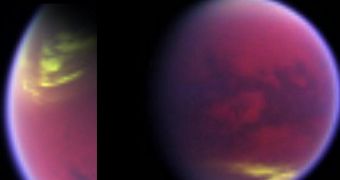According to the latest observations by the NASA Cassini orbiter around Saturn, it would appear that spring has finally come on the gas giant's largest moon, Titan.
The skies above the space body's polar regions have been constantly clearing since August last year, when the last equinox took place. A fine spring weather has now been observed at those locations.
Admittedly, in the case of Titan, a fine day is a bit chilly by human standards, with temperatures dipping to an average of minus 173 degrees Celsius. This is enough to make ice tougher than granite.
The clouds above Titan's poles have been under constant surveillance for more than a year. NASA experts have used the VIMS instrument on the orbiter to conduct the investigations.
Taking advantage of the long time Cassini has spent around Titan, a team of investigators from France has recently developed the first map of weather on Titan, after browsing through more than 2,000 images collected with the Visual and Infrared Mapping Spectrometer.
The research group was led by expert Sebastien Rodriguez, who is based at the Universite Paris Diderot's AIM laboratory, Euro Planet reports.
This work basically represents the first long-term study of Titan’s weather. The map even includes details about the moon's equinox periods, the research group adds.
Rodriguez will be presenting the results of his team's investigations today, September 22, at the European Planetary Science Congress. The meeting is held in the Italian capital, Rome.
“Over the past six years, we’ve found that clouds appear clustered in three distinct latitude regions of Titan: large clouds at the north pole, patchy cloud at the south pole and a narrow belt around 40 degrees south,” the team leader says.
“However, we are now seeing evidence of a seasonal circulation turnover on Titan – the clouds at the south pole completely disappeared just before the equinox and the clouds in the north are thinning out,” he adds.
“This agrees with predictions from models and we are expecting to see cloud activity reverse from one hemisphere to another in the coming decade as southern winter approaches,” the expert goes on to say.
Each season on Titan lasts for about 7 Earth years, given that distance the moon orbits from the Sun.
The cosmic body's last summer season in the southern hemisphere (winter in the northern hemisphere) began in July 2004, and ended in April 2010.
“We have learned a lot about Titan’s climate since Cassini arrived in at Saturn but there is still a great deal to learn. With the new mission extension, we will have the opportunity to answer some of the key questions about the meteorology of this fascinating moon,” Rodriguez concludes.

 14 DAY TRIAL //
14 DAY TRIAL //